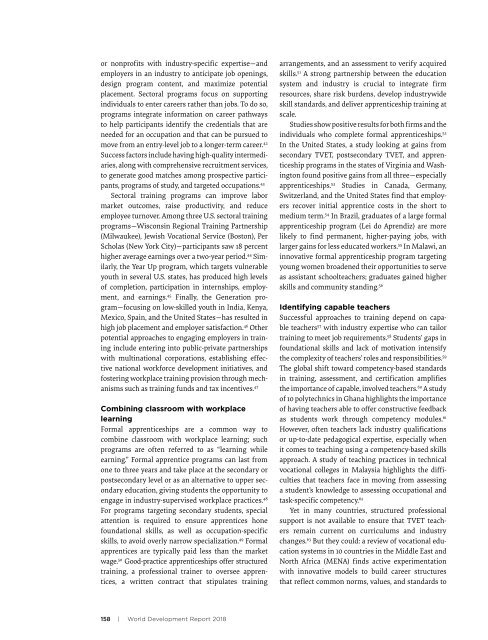Brasil só deve dominar Leitura em 260 anos, aponta estudo do Banco Mundial Relatorio Banco Mundial _Learning
You also want an ePaper? Increase the reach of your titles
YUMPU automatically turns print PDFs into web optimized ePapers that Google loves.
or nonprofits with industry-specific expertise—and<br />
<strong>em</strong>ployers in an industry to anticipate job openings,<br />
design program content, and maximize potential<br />
plac<strong>em</strong>ent. Sectoral programs focus on supporting<br />
individuals to enter careers rather than jobs. To <strong>do</strong> so,<br />
programs integrate information on career pathways<br />
to help participants identify the credentials that are<br />
needed for an occupation and that can be pursued to<br />
move from an entry-level job to a longer-term career. 42<br />
Success factors include having high-quality intermediaries,<br />
along with comprehensive recruitment services,<br />
to generate good matches among prospective participants,<br />
programs of study, and targeted occupations. 43<br />
Sectoral training programs can improve labor<br />
market outcomes, raise productivity, and reduce<br />
<strong>em</strong>ployee turnover. Among three U.S. sectoral training<br />
programs—Wisconsin Regional Training Partnership<br />
(Milwaukee), Jewish Vocational Service (Boston), Per<br />
Scholas (New York City)—participants saw 18 percent<br />
higher average earnings over a two-year period. 44 Similarly,<br />
the Year Up program, which targets vulnerable<br />
youth in several U.S. states, has produced high levels<br />
of completion, participation in internships, <strong>em</strong>ployment,<br />
and earnings. 45 Finally, the Generation program—focusing<br />
on low-skilled youth in India, Kenya,<br />
Mexico, Spain, and the United States—has resulted in<br />
high job plac<strong>em</strong>ent and <strong>em</strong>ployer satisfaction. 46 Other<br />
potential approaches to engaging <strong>em</strong>ployers in training<br />
include entering into public-private partnerships<br />
with multinational corporations, establishing effective<br />
national workforce <strong>deve</strong>lopment initiatives, and<br />
fostering workplace training provision through mechanisms<br />
such as training funds and tax incentives. 47<br />
Combining classroom with workplace<br />
learning<br />
Formal apprenticeships are a common way to<br />
combine classroom with workplace learning; such<br />
programs are often referred to as “learning while<br />
earning.” Formal apprentice programs can last from<br />
one to three years and take place at the secondary or<br />
postsecondary level or as an alternative to upper secondary<br />
education, giving students the opportunity to<br />
engage in industry-supervised workplace practices. 48<br />
For programs targeting secondary students, special<br />
attention is required to ensure apprentices hone<br />
foundational skills, as well as occupation-specific<br />
skills, to avoid overly narrow specialization. 49 Formal<br />
apprentices are typically paid less than the market<br />
wage. 50 Good-practice apprenticeships offer structured<br />
training, a professional trainer to oversee apprentices,<br />
a written contract that stipulates training<br />
arrang<strong>em</strong>ents, and an assessment to verify acquired<br />
skills. 51 A strong partnership between the education<br />
syst<strong>em</strong> and industry is crucial to integrate firm<br />
resources, share risk burdens, <strong>deve</strong>lop industrywide<br />
skill standards, and deliver apprenticeship training at<br />
scale.<br />
Studies show positive results for both firms and the<br />
individuals who complete formal apprenticeships. 52<br />
In the United States, a study looking at gains from<br />
secondary TVET, postsecondary TVET, and apprenticeship<br />
programs in the states of Virginia and Washington<br />
found positive gains from all three—especially<br />
apprenticeships. 53 Studies in Canada, Germany,<br />
Switzerland, and the United States find that <strong>em</strong>ployers<br />
recover initial apprentice costs in the short to<br />
medium term. 54 In Brazil, graduates of a large formal<br />
apprenticeship program (Lei <strong>do</strong> Aprendiz) are more<br />
likely to find permanent, higher-paying jobs, with<br />
larger gains for less educated workers. 55 In Malawi, an<br />
innovative formal apprenticeship program targeting<br />
young women broadened their opportunities to serve<br />
as assistant schoolteachers; graduates gained higher<br />
skills and community standing. 56<br />
Identifying capable teachers<br />
Successful approaches to training depend on capable<br />
teachers 57 with industry expertise who can tailor<br />
training to meet job requir<strong>em</strong>ents. 58 Students’ gaps in<br />
foundational skills and lack of motivation intensify<br />
the complexity of teachers’ roles and responsibilities. 59<br />
The global shift toward competency-based standards<br />
in training, assessment, and certification amplifies<br />
the importance of capable, involved teachers. 60 A study<br />
of 10 polytechnics in Ghana highlights the importance<br />
of having teachers able to offer constructive feedback<br />
as students work through competency modules. 61<br />
However, often teachers lack industry qualifications<br />
or up-to-date pedagogical expertise, especially when<br />
it comes to teaching using a competency-based skills<br />
approach. A study of teaching practices in technical<br />
vocational colleges in Malaysia highlights the difficulties<br />
that teachers face in moving from assessing<br />
a student’s knowledge to assessing occupational and<br />
task-specific competency. 62<br />
Yet in many countries, structured professional<br />
support is not available to ensure that TVET teachers<br />
r<strong>em</strong>ain current on curriculums and industry<br />
changes. 63 But they could: a review of vocational education<br />
syst<strong>em</strong>s in 10 countries in the Middle East and<br />
North Africa (MENA) finds active experimentation<br />
with innovative models to build career structures<br />
that reflect common norms, values, and standards to<br />
158 | World Development Report 2018








